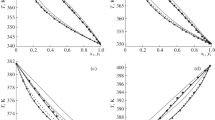Abstract
The phase diagrams of ternary systems [Th(NO3)4(TBP)2]-decane-third organic component (n-butanol, n-octanol, isobutanol, dimethylhexanol, chloroform, carbon tetrachloride, o-dichlorobenzene, tri-n-butyl phosphate, o-xylene, toluene, and linear carboxylic acids) were studied in the temperature range 288.15–333.15 K. These diagrams contain the fields of homogeneous solutions and the field of separation into two liquid phases (I, II). Phase I is enriched in Th(NO3)4(TBP)2 and third component and phase II is enriched in decane. The phase separation is not appreciably influenced by temperature. In phase separation, the third component is predominantly concentrated in phase I, in spite of the fact that the third component and decane have infinite mutual solubility at all the temperatures. The composition of the ternary systems in the critical point is dependent on the kind of the third component.
Similar content being viewed by others
References
Rozen, A.M., in Ekstraktsiya. Teoriya, primenenie, apparatura: Sbornik nauchnykh trudov (Extraction. Theory, Applications, Equipment: Coll. of Scientific Works), Moscow: Gosatomizdat, 1962, issue 1, pp. 6–87.
Nikolotova, Z.I., in Ekstraktsiya neitral’nymi fosfororganicheskimi soedineniyami. Aktinoidy: Spravochnik (Extraction with Neutral Organophosphorus Compounds. Actinides: Handbook), Moscow: Energoatomizdat, 1987.
Ekstraktsiya neorganicheskikh veshchestv (diagrammy rassloeniya, raspredeleniya, vysalivaniya i razdeleniya) (Extraction of Inorganic Substances (Diagrams of Phase Separation, Distribution, Salting-Out, and Separation)), Nikolaev, A.V., Ed., Novosibirsk: Nauka, 1970.
Zilberman, B.Ya., Fedorov, Yu.S., Kopyrin, A.A., et al., Radiokhimiya, 2001, vol. 43, no. 2, pp. 155–159.
Pyartman, A.K., Kudrova, A.V., and Keskinov, V.A., Radiokhimiya, 2004, vol. 46, no. 6, pp. 546–548.
Pyartman, A.K., Kudrova, A.V., and Keskinov, V.A., Zh. Neorg. Khim., 2005, vol. 50, no. 6, pp. 1–6.
Pyartman, A.K., Kopyrin, A.A., Berinskii, A.E., and Keskinov, V.A., Radiokhimiya, 2000, vol. 42, no. 2, pp. 128–130.
Přibil, R., Analytical Applications of EDTA and Related Compounds, Oxford: Pergamon, 1972.
Author information
Authors and Affiliations
Additional information
Original Russian Text © A.K. Pyartman, V.A. Keskinov, V.V. Lishchuk, I.A. Spiridonova, 2006, published in Radiokhimiya, 2006, Vol. 48, No. 3, pp. 246–251.
Rights and permissions
About this article
Cite this article
Pyartman, A.K., Keskinov, V.A., Lishchuk, V.V. et al. Influence of temperature on phase separation in the ternary systems [Th(NO3)4(TBP)2]-decane-third organic component. Radiochemistry 48, 272–278 (2006). https://doi.org/10.1134/S106636220603012X
Received:
Accepted:
Issue Date:
DOI: https://doi.org/10.1134/S106636220603012X




